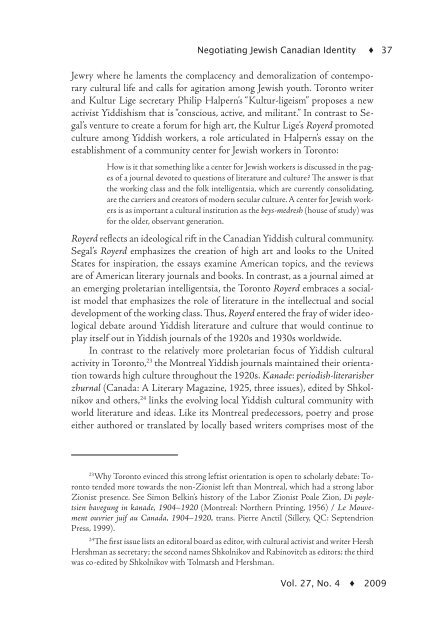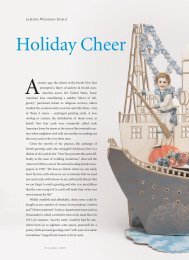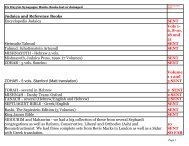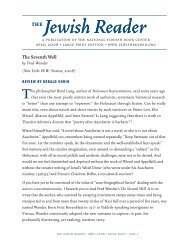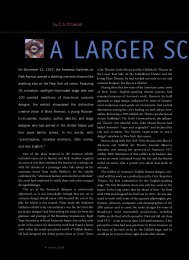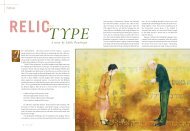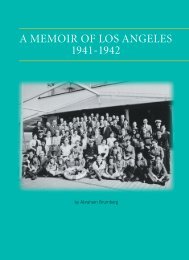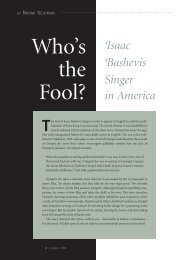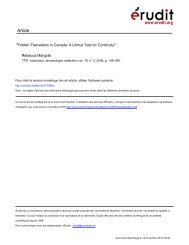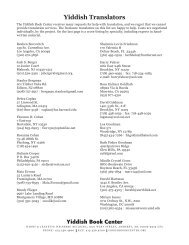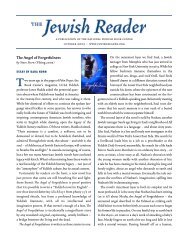Negotiating Jewish Canadian Identity Montreal Yiddish Literary ...
Negotiating Jewish Canadian Identity Montreal Yiddish Literary ...
Negotiating Jewish Canadian Identity Montreal Yiddish Literary ...
You also want an ePaper? Increase the reach of your titles
YUMPU automatically turns print PDFs into web optimized ePapers that Google loves.
<strong>Negotiating</strong> <strong>Jewish</strong> <strong>Canadian</strong> <strong>Identity</strong> ♦ 37Jewry where he laments the complacency and demoralization of contemporarycultural life and calls for agitation among <strong>Jewish</strong> youth. Toronto writerand Kultur Lige secretary Philip Halpern’s “Kultur-ligeism” proposes a newactivist <strong>Yiddish</strong>ism that is “conscious, active, and militant.” In contrast to Segal’sventure to create a forum for high art, the Kultur Lige’s Royerd promotedculture among <strong>Yiddish</strong> workers, a role articulated in Halpern’s essay on theestablishment of a community center for <strong>Jewish</strong> workers in Toronto:How is it that something like a center for <strong>Jewish</strong> workers is discussed in the pagesof a journal devoted to questions of literature and culture? The answer is thatthe working class and the folk intelligentsia, which are currently consolidating,are the carriers and creators of modern secular culture. A center for <strong>Jewish</strong> workersis as important a cultural institution as the beys-medresh (house of study) wasfor the older, observant generation.Royerd reflects an ideological rift in the <strong>Canadian</strong> <strong>Yiddish</strong> cultural community.Segal’s Royerd emphasizes the creation of high art and looks to the UnitedStates for inspiration, the essays examine American topics, and the reviewsare of American literary journals and books. In contrast, as a journal aimed atan emerging proletarian intelligentsia, the Toronto Royerd embraces a socialistmodel that emphasizes the role of literature in the intellectual and socialdevelopment of the working class. Thus, Royerd entered the fray of wider ideologicaldebate around <strong>Yiddish</strong> literature and culture that would continue toplay itself out in <strong>Yiddish</strong> journals of the 1920s and 1930s worldwide.In contrast to the relatively more proletarian focus of <strong>Yiddish</strong> culturalactivity in Toronto, 23 the <strong>Montreal</strong> <strong>Yiddish</strong> journals maintained their orientationtowards high culture throughout the 1920s. Kanade: periodish-literarisherzhurnal (Canada: A <strong>Literary</strong> Magazine, 1925, three issues), edited by Shkolnikovand others, 24 links the evolving local <strong>Yiddish</strong> cultural community withworld literature and ideas. Like its <strong>Montreal</strong> predecessors, poetry and proseeither authored or translated by locally based writers comprises most of the23Why Toronto evinced this strong leftist orientation is open to scholarly debate: Torontotended more towards the non-Zionist left than <strong>Montreal</strong>, which had a strong laborZionist presence. See Simon Belkin’s history of the Labor Zionist Poale Zion, Di poyletsienbavegung in kanade, 1904–1920 (<strong>Montreal</strong>: Northern Printing, 1956) / Le Mouvementouvrier juif au Canada, 1904–1920, trans. Pierre Anctil (Sillery, QC: SeptendrionPress, 1999).24The first issue lists an editoral board as editor, with cultural activist and writer HershHershman as secretary; the second names Shkolnikov and Rabinovitch as editors; the thirdwas co-edited by Shkolnikov with Tolmatsh and Hershman.Vol. 27, No. 4 ♦ 2009


